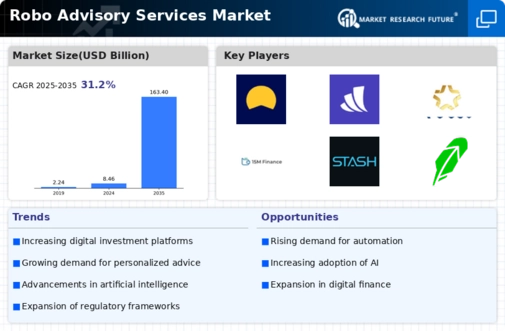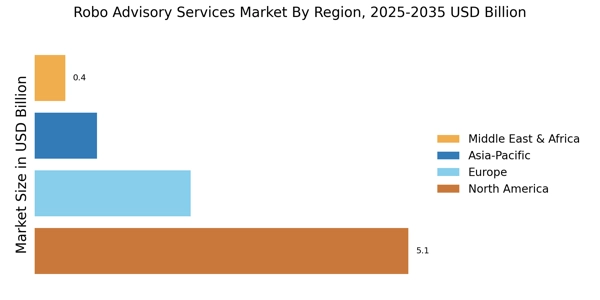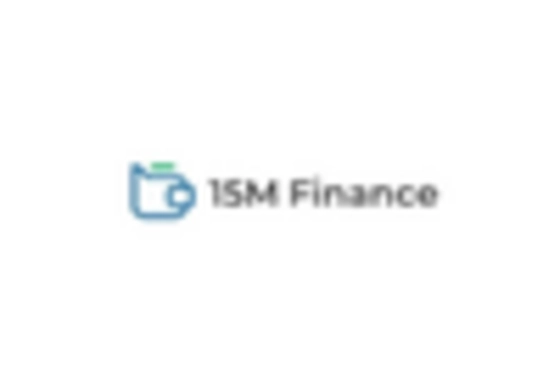Cost Efficiency
Cost efficiency remains a pivotal driver in the Robo Advisory Services Market, as these platforms typically offer lower fees compared to traditional financial advisors. The average management fee for robo-advisors is around 0.25% to 0.50%, significantly lower than the 1% to 2% charged by conventional advisors. This cost advantage is particularly appealing to younger investors and those with smaller portfolios, who may find traditional advisory services prohibitively expensive. As the market continues to evolve, the emphasis on cost-effective solutions is likely to attract a larger client base, thereby contributing to the growth of the industry. Additionally, the ability to automate investment processes reduces operational costs for firms, allowing them to pass savings onto clients. This dynamic creates a competitive edge for robo-advisors, positioning them as a viable alternative in the financial advisory landscape.
Regulatory Support
Regulatory support is increasingly influencing the Robo Advisory Services Market, as governments and financial authorities recognize the potential of these platforms to democratize access to investment services. In recent years, several jurisdictions have introduced favorable regulations that facilitate the operation of robo-advisors, thereby enhancing consumer protection and promoting transparency. For instance, regulations that require robo-advisors to disclose their algorithms and investment strategies are gaining traction, which may bolster consumer trust. As of 2025, the regulatory environment appears to be evolving positively, with more countries considering frameworks that support the growth of digital financial services. This supportive regulatory landscape is likely to encourage new entrants into the market, fostering innovation and competition, which could further accelerate the adoption of robo-advisory services among various demographics.
Technological Advancements
The Robo Advisory Services Market is experiencing a surge in technological advancements, which are reshaping the landscape of financial advisory services. Innovations in artificial intelligence and machine learning are enabling robo-advisors to provide more personalized investment strategies. As of 2025, the market is projected to reach a valuation of approximately 1.5 trillion USD, driven by these technological enhancements. Furthermore, the integration of advanced algorithms allows for real-time data analysis, which enhances decision-making processes for investors. This technological evolution not only improves user experience but also increases the efficiency of portfolio management, making robo-advisors more appealing to a broader audience. Consequently, the proliferation of technology in this sector is likely to attract a diverse range of clients, from novice investors to seasoned professionals, thereby expanding the overall market.
Increased Financial Literacy
Increased financial literacy is emerging as a crucial driver in the Robo Advisory Services Market, as more individuals become educated about investment options and financial planning. Educational initiatives and resources are proliferating, empowering consumers to make informed decisions regarding their finances. As financial literacy improves, individuals are more likely to seek out robo-advisory services, recognizing their potential for effective portfolio management. The market is projected to grow as a result, with an anticipated increase in the number of users seeking automated investment solutions. Furthermore, as consumers become more knowledgeable, they may demand more sophisticated features from robo-advisors, prompting firms to innovate and enhance their service offerings. This trend towards greater financial understanding is likely to create a more robust market environment, fostering competition and driving the evolution of robo-advisory services.
Changing Consumer Preferences
Changing consumer preferences are significantly impacting the Robo Advisory Services Market, as investors increasingly seek convenience and accessibility in financial services. The rise of digital natives, who are accustomed to technology-driven solutions, is driving demand for robo-advisors that offer user-friendly interfaces and seamless experiences. As of 2025, it is estimated that over 50% of millennials and Gen Z investors prefer using robo-advisors for their investment needs, reflecting a shift in attitudes towards traditional financial advisory services. This generational shift is likely to continue, as younger investors prioritize flexibility and lower costs. Consequently, robo-advisors are adapting their offerings to meet these evolving preferences, which may include enhanced mobile applications and personalized investment options. This alignment with consumer expectations is expected to propel the growth of the industry in the coming years.


















Leave a Comment